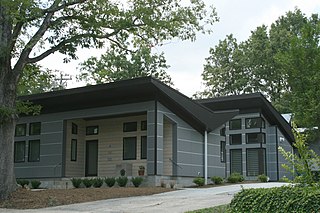
Energy Star is a program run by the U.S. Environmental Protection Agency (EPA) and U.S. Department of Energy (DOE) that promotes energy efficiency. Energy Star provides information on the energy consumption of products and devices, using standardized methods. The Energy Star label, can be found on more than 75 different product categories, new homes, commercial buildings and industrial plants.

Green building refers to both a structure and the application of processes that are environmentally responsible and resource-efficient throughout a building's life-cycle: from planning to design, construction, operation, maintenance, renovation, and demolition. This requires close cooperation of the contractor, the architects, the engineers, and the client at all project stages. The Green Building practice expands and complements the classical building design concerns of economy, utility, durability, and comfort.

A low-energy house is characterized by an energy-efficient design and technical features which enable it to provide high living standards and comfort with low energy consumption and carbon emissions. Traditional heating and active cooling systems are absent, or their use is secondary. Low-energy buildings may be viewed as examples of sustainable architecture. Low-energy houses often have active and passive solar building design and components, which reduce the house's energy consumption and minimally impact the resident’s lifestyle. Throughout the world, companies and non-profit organizations provide guidelines and issue certifications to guarantee the energy performance of buildings and their processes and materials. Certifications include passive house, BBC - Bâtiment Basse Consommation - Effinergie (France), zero-carbon house (UK), and Minergie (Switzerland).

Leadership in Energy and Environmental Design (LEED) is one of the most popular green building certification programs used worldwide. Developed by the non-profit U.S. Green Building Council (USGBC) it includes a set of rating systems for the design, construction, operation, and maintenance of green buildings, homes, and neighborhoods that aims to help building owners and operators be environmentally responsible and use resources efficiently.

A zero-energy building (ZE), also known as a zero net energy (ZNE) building, net-zero energy building (NZEB), net zero building is a building with zero net energy consumption, meaning the total amount of energy used by the building on an annual basis is equal to the amount of renewable energy created on the site, or in other definitions by renewable energy sources offsite. In some cases these buildings consequently contribute less overall greenhouse gas to the atmosphere during operations than similar non-ZNE buildings. They do at times consume non-renewable energy and produce greenhouse gases, but at other times reduce energy consumption and greenhouse gas production elsewhere by the same amount. A similar concept approved and implemented by the European Union and other agreeing countries is nearly Zero Energy Building (nZEB), with the goal of having all buildings in the region under nZEB standards by 2020. Terminology tends to vary between countries and agencies; the IEA and European Union most commonly use "net zero", with "zero net" mainly used in the USA.

The U.S. Green Building Council (USGBC), co-founded by Mike Italiano, David Gottfried and Rick Fedrizzi in 1993, is a private 501(c)3, membership-based non-profit organization that promotes sustainability in building design, construction, and operation. USGBC is best known for its development of the Leadership in Energy and Environmental Design (LEED) green building rating systems and its annual Greenbuild International Conference and Expo, the world’s largest conference and expo dedicated to green building. USGBC was one of eight national councils that helped found the World Green Building Council (WorldGBC). The current president and CEO is Mahesh Ramanujam who acquired this role in January 2017 after co-founder Rick Fedrizzi.

Cradle-to-cradle design is a biomimetic approach to the design of products and systems that models human industry on nature's processes viewing materials as nutrients circulating in healthy, safe metabolisms. The term itself is a play on the popular corporate phrase "cradle to grave", implying that the C2C model is sustainable and considerate of life and future generations—from the birth, or "cradle", of one generation to the next generation, versus from birth to death, or "grave", within the same generation.
A Home Energy Rating is a measurement of a home's energy efficiency. In the United States, the Residential Energy Services Network (RESNET) is responsible for creation and maintenance of the RESNET Mortgage Industry National Home Energy Rating Standards, as well as certification and quality assurance on RESNET Provider organizations.

80 Plus is a voluntary certification program intended to promote efficient energy use in computer power supply units (PSUs). Launched in 2004 by Ecos Consulting, it certifies products that have more than 80% energy efficiency at 20%, 50% and 100% of rated load, and a power factor of 0.9 or greater at 100% load. Such PSUs waste 20% or less electric energy as heat at the specified load levels, reducing electricity use and bills compared to less efficient PSUs.
This article provides examples of Green Building programs in the United States. These programs span the public, private, and non-profit sectors, and all have the goal of increasing energy efficiency and the sustainability of the built environment.
NAHBGreen is another name for the National Green Building Program of the National Association of Home Builders, an organization based in the United States.
The Builders Challenge is a high-performance housing recognition initiative led by the U.S. Department of Energy (DOE) Office of Energy Efficiency and Renewable Energy through its Building Technologies Program. The voluntary program with incentives was announced by the DOE on 14 February 2008. Through the Builders Challenge, participating homebuilders can more easily differentiate their high energy-performance homes from other less energy-efficient products in the marketplace by means of a standardized energy rating system. “Best energy-performing” is defined by the DOE as scoring 70 or lower on the EnergySmart Home Scale (E-Scale), that is, at least 30 percent more efficient than a typical home built per the 2004 International Energy Conservation Code. The Builders Challenge aims for 1.3 million homes scoring 70 or lower to be constructed by 2030 thereby saving $1.7 billion in energy costs per DOE estimate.
Canada has implemented the "R-2000" in 1982 to promote better than building code construction to increase energy efficiency and promote sustainability. An optional feature of the R-2000 home program is the EnerGuide rating service. This service is available across Canada, allows home builders and home buyers to measure and rate the performance of their homes, and confirm that those specifications have been met. Some Canadian provinces are considering mandatory use of the service for all new homes.
Green building on college campuses is the purposeful construction of buildings on college campuses that decreases resource usage in both the building process and also the future use of the building. The goal is to reduce CO
2 emissions, energy use, and water use, while creating an atmosphere where students can be healthy and learn. Universities across the country are building to green standards set forth by the USGBC, United States Green Building Council. The USGBC is a non-profit organization that promotes sustainability in how buildings are designed and built. This organization created the Leadership in Energy and Environmental Design (LEED) rating system, which is a certification process that provides verification that a building is environmentally sustainable. In the United States, commercial and residential buildings account for 70 percent of the electricity use and over 38 percent of CO
2 emissions. Because of these huge statistics regarding resource usage and emissions, the room for more efficient building practices is dramatic. Since college campuses are where the world's future leaders are being taught, colleges are choosing to construct new buildings to green standards in order to promote environmental stewardship to their students. Colleges across the United States have taken leading roles in the construction of green building in order to reduce resource consumption, save money in the long run, and instill the importance on environmental sustainability on their students.It is a better way to motivate new generation to live a sustainable life.

Joseph Lstiburek is a forensic engineer, building investigator, building science consultant, author, speaker and widely known expert on building moisture control, indoor air quality, and retro-fit of existing and historic buildings.

A green home is a type of house designed to be environmentally sustainable. Green homes focus on the efficient use of "energy, water, and building materials". A green home may utilize sustainably sourced, environmentally friendly, and/or recycled building materials. It may include sustainable energy sources such as solar or geothermal, and be sited to take maximum advantage of natural features such as sunlight and tree cover to improve energy efficiency.
A sustainability organization is (1) an organized group of people that aims to advance sustainability and/or (2) those actions of organizing something sustainably. Unlike many business organizations, sustainability organizations are not limited to implementing sustainability strategies which provide them with economic and cultural benefits attained through environmental responsibility. For sustainability organizations, sustainability can also be an end in itself without further justifications.
LEED for Neighborhood Development (LEED-ND), where "LEED" stands for Leadership in Energy and Environmental Design, is a United States-based rating system that integrates the principles of smart growth, urbanism and green building into a national system for neighborhood design. LEED certification provides independent, third-party verification that a development's location and design meet accepted high levels of environmentally responsible, sustainable development.
The North Carolina Solar Center is a resource center for sustainable energy programs located at North Carolina State University in Raleigh, North Carolina. When it was created in 1988, the center's focus was solar energy. The N.C. Solar Center now serves as a resource for innovative, clean energy technologies through demonstration, technical assistance, outreach and training. It also administers the Database of Incentives for Renewables & Efficiency (DSIRE), a resource providing financial incentives and policies in the energy industry.
The National Green Building Standard (NGBS) is an ANSI-approved green building certification program, specifically focused on single-family and multi-family residential buildings, remodeling projects, and land developments.









